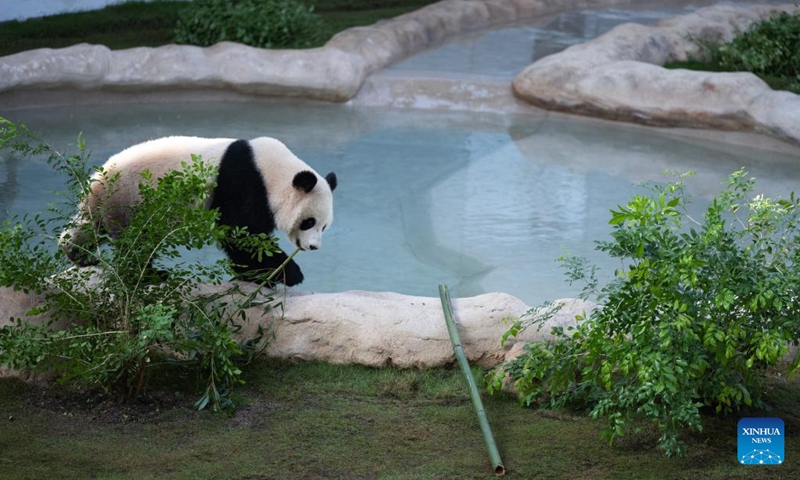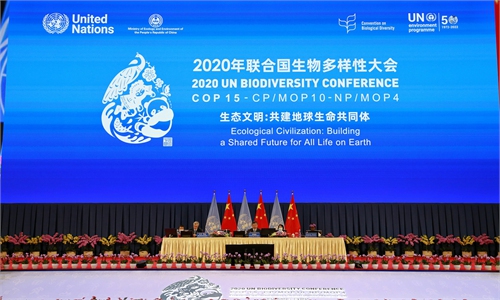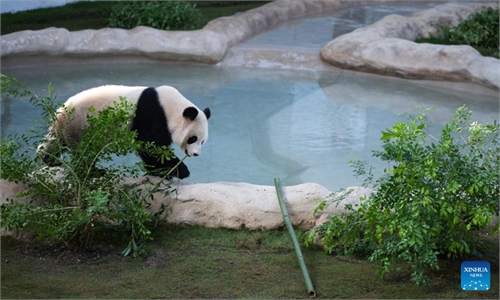China retains COP 15 presidency in Montreal, expects to reach Post-2020 Global Biodiversity Framework

The giant panda Si Hai is seen at the Panda House at Al Khor Park in Doha, Qatar, Nov. 17, 2022. The two giant pandas, three-year-old female Si Hai and four-year-old male Jing Jing, made their first public appearance on Thursday ahead of the FIFA World Cup Qatar 2022. (Xinhua/Xiao Yijiu)
China, having fulfilled the responsibilities of the COP15 presidency, has been giving full play to the driving force and coordinating role from multiple perspectives and has made positive progress, China's environmental authority reaffirmed ahead of the second phase of the global event on biodiversity conservation.
The second part of the COP15, or the Conference of the Parties (COP15) to the UN Convention on Biological Diversity (CBD), is scheduled for December 7-19 in Montreal, Canada, with China as chair.
"At present, all preparations for the meeting are basically in place," Cui Shuhong, director of the Department of Nature and Ecology Conservation at the Ministry of Ecology and Environment, said at the ministry's press conference on Monday.
The first part of the COP15 was held in 2021 in Kunming, Southwest China's Yunnan Province. The second part was postponed and relocated to Canada due to the COVID-19 pandemic, the Xinhua News Agency reported in June 2022, quoting the MEE's announcement. "China will continue to act as chair of COP15 in guiding substantive and political affairs," it says.
China attaches great importance to biodiversity protection and will continue to work with all parties and stakeholders in the second phase of COP15 to advance negotiations on the global biodiversity framework.
The COP15 will formulate the landmark "Post-2020 Global Biodiversity Framework," to clarify new global biodiversity protection goals, and promote the transformation and reform of global biodiversity governance, Cui said at the Monday press conference.
He urged the world to fully learn from the experiences and lessons during the implementation of the "Aichi Biodiversity Targets" when formulating new global targets. "We should not only boost ambition and confidence in the global biodiversity conservation, but also be down-to-earth and realistic, fully considering the attainability and operability of the targets and the development differences of different countries," he said.
He urged the framework to pay attention to the lack of capacity building in developing countries. "In terms of funds, technology, and talent, as one of the countries with the richest biodiversity in the world, China has conscientiously implemented the Aichi Biodiversity Targets, clarified various tasks and responsibilities, and achieved positive results in the implementations," Cui noted.
Cui said that China has taken new steps in making biodiversity conservation a mainstream task in society in recent years. For instance, the country has emphasized the implementation of major biodiversity conservation projects, deeply implementing laws on biodiversity and published several new laws, and has officially initiated the first of five national parks around the country, covering a total 30 percent of key protected wildlife and plants on land.
Zhou Guomei, director of the MEE's Department of International Cooperation, said that as a developing country, China has done its best in the process of biodiversity conservation, and cooperated with other developing countries to promote ecological protection and biodiversity conservation.
The area of China-Laos cross-border biodiversity joint protection zone, for instance, has reached 200,000 hectares, providing a good mechanism for effectively protecting rare and endangered species such as Asian elephants and their habitats.
China has helped train more than 200 people on biodiversity from African countries, establishing a talent team for indigenous biodiversity conservation in Africa, according to Zhou.
The Chinese government has been encouraging and guiding Chinese companies to apply green development theory in overseas investments, she further stated.
The Mombasa-Nairobi Railway in Kenya has set up large animal passages, bridges, and culverts to ensure the free migration of wildlife. Another example is that during the construction of the container terminal project in Ghana, a sea turtle breeding center was specially established to release turtle hatchlings.
At least 96 ministers and over 10,000 registered delegates are confirmed to join the event in biodiversity protection, UN officials said in early November, the Xinhua News Agency reported.



